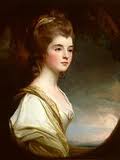Countess of Sutherland (1): Difference between revisions
No edit summary |
No edit summary |
||
| Line 21: | Line 21: | ||
<br> | <br> | ||
<br> | <br> | ||
[[File:ladysutherland.jpg|200px|thumb|left|Lady Sutherland]] | |||
On the death of the 18th Earl of Sutherland, William Gordon, without male issue, the title passed to his daughter Elizabeth (1765-1839). She became the 19th Countess of Sutherland only a few weeks after her first birthday, in 1766. She married an Englishman, George Granville Leveson-Gower, Marquis of Stafford, in September, 1785, and later became Duchess when Stafford was created Duke of Sutherland in 1833. Elizabeth was a distinguished artist and painter. Their reputation has been marred by their ill-treatment of tenants in the matter of the Highland clearances, initiated to "improve" their estates by displacing people in favour of sheep. She is said to have pursued the depopulation of her lands with "vigour and cruel thoroughness," so that "her name is still reviled in many homes with Highland connections across the world today." Karl Marx wrote an article condemning her practices, entitled "The Duchess of Sutherland and Slavery" ('''The People's Paper''', March 12, 1853). Artist George Romney painted her portrait in 1782, at age seventeen, three years before she married Leveson-Gower. [George Romney also painted a number of paintings of Emma Hart, Lady Hamilton, for whom see the alternate title of "Countess of Sutherland"]. | On the death of the 18th Earl of Sutherland, William Gordon, without male issue, the title passed to his daughter Elizabeth (1765-1839). She became the 19th Countess of Sutherland only a few weeks after her first birthday, in 1766. She married an Englishman, George Granville Leveson-Gower, Marquis of Stafford, in September, 1785, and later became Duchess when Stafford was created Duke of Sutherland in 1833. Elizabeth was a distinguished artist and painter. Their reputation has been marred by their ill-treatment of tenants in the matter of the Highland clearances, initiated to "improve" their estates by displacing people in favour of sheep. She is said to have pursued the depopulation of her lands with "vigour and cruel thoroughness," so that "her name is still reviled in many homes with Highland connections across the world today." Karl Marx wrote an article condemning her practices, entitled "The Duchess of Sutherland and Slavery" ('''The People's Paper''', March 12, 1853). Artist George Romney painted her portrait in 1782, at age seventeen, three years before she married Leveson-Gower. [George Romney also painted a number of paintings of Emma Hart, Lady Hamilton, for whom see the alternate title of "Countess of Sutherland"]. | ||
<br> | <br> | ||
Revision as of 23:20, 5 July 2012
COUNTESS OF SUTHERLAND [1]. AKA and see "Glasgow Ladys," "Lady Hamilton (3)." Scottish, Reel. B Flat Major (Athole, Gow, Hunter, Kerr, Skye): C Major (Hardings, Surenne). Standard tuning (fiddle). AB (Kerr, Surenne): AAB (Athole, Gow, Hunter, Skye): AABB (Hardings). Composed by George Jenkins, a dancing master in London who may or may not have been of Scottish birth. Several writers have pointed out that many of his compositions seem to lack a genuine Scottish idiom.

On the death of the 18th Earl of Sutherland, William Gordon, without male issue, the title passed to his daughter Elizabeth (1765-1839). She became the 19th Countess of Sutherland only a few weeks after her first birthday, in 1766. She married an Englishman, George Granville Leveson-Gower, Marquis of Stafford, in September, 1785, and later became Duchess when Stafford was created Duke of Sutherland in 1833. Elizabeth was a distinguished artist and painter. Their reputation has been marred by their ill-treatment of tenants in the matter of the Highland clearances, initiated to "improve" their estates by displacing people in favour of sheep. She is said to have pursued the depopulation of her lands with "vigour and cruel thoroughness," so that "her name is still reviled in many homes with Highland connections across the world today." Karl Marx wrote an article condemning her practices, entitled "The Duchess of Sutherland and Slavery" (The People's Paper, March 12, 1853). Artist George Romney painted her portrait in 1782, at age seventeen, three years before she married Leveson-Gower. [George Romney also painted a number of paintings of Emma Hart, Lady Hamilton, for whom see the alternate title of "Countess of Sutherland"].
See also the related Irish reels "Tansey's Favourite (1)," "Bloom of Youth (The)," "Doctor Taylor," "Downshire Reel (The)," and "Gardiner's Favourite (1)."
Printed sources: Carlin (The Gow Collection), 1986; No. 242. Gow (The First Collection of Niel Gow's Reels), 1784 (revised 1801); p. 32. Harding's All Round Collection, 1905; No. 30, p. 9. Hunter (Fiddle Music of Scotland), 1988; No. 264 (arranged for string quintet). Kerr (Merry Melodies), vol. 3; No. 174, p. 20. Köhlers’ Violin Repository, Book 1 , 1881-1885; p. 69. MacDonald (The Skye Collection), 1887; p. 148. Stewart-Robertson (The Athole Collection), 1884; p. 288. Surenne (Dance Music of Scotland), 1852; p. 19.
X:1 T:Countess of Sutherland [1] M:C| L:1/8 R:Reel B:Stewart-Robertson - The Athole Collection (1884) Z:AK/Fiddler's Companion K:Bb f|~B2 FB GBFB|EBDB Cccd|~B2 FB Ggfe|dfce dBB:| (3f/g/a/|bfdf egce|dfBd cF Ff/g/4a/4|bfdf egce|dfce dB Bf/g/4a/4| bfdf egce|dfBd cFFf|gfga bgfe|dfce dB~B||
X:2 T:Countess of Sutherland [1] M:C L:1/8 R:Reel S:Surenne - Dance Music of Scotland, p. 19 (1852) Z:AK/Fiddler's Companion K:C e | c2 Gc AcGc | FcEc Ddde | c2 Gc Aagf | egdf ecce | c2 Gc AcGc | FcEc Ddde | c2 Gc Aagf | egdf ecc || (3g/a/b/ | c'geg fadf | egce dGGb | c'geg fadf | egfd eccb | c'geg fadf | egce dGGg | agab c'agf | egdf ecc ||
X:1 T:Countess of Sutherland’s Reel M:C| L:1/8 C:Geo. Jenkins B: Köhlers’ Violin Repository, Book 1 (1881-1885, p. 69) Z:AK/Fiddler’s Companion K:Bb d|B2 FB GBFB|EBDB Cccd|B2 FB Ggfe|dfce dBB:|| a|bfdf egce|dfBd cFFa|bfdf egce|dfce dBBa| bfdf egce|dfBd cFFf|gfga bgfe|dfce dBB||
© 1996-2010 Andrew Kuntz. All Rights Reserved.
Engraver Valerio M. Pelliccioni

